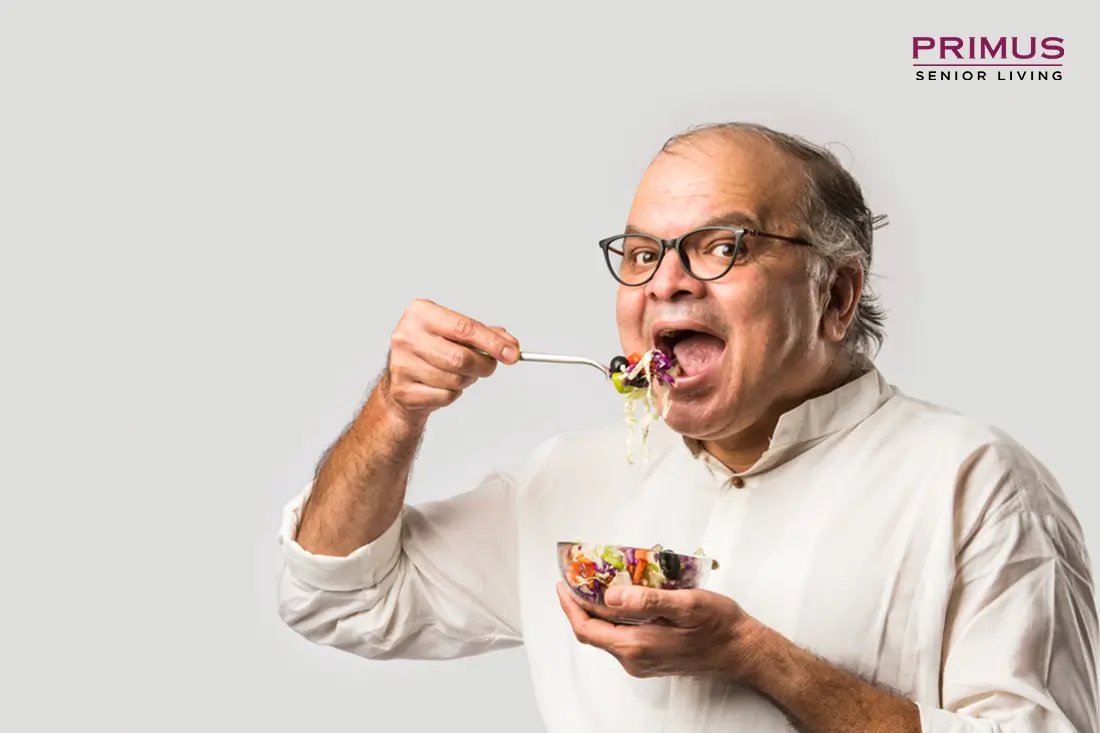Ageing isn’t just growing older; it’s growing richer in stories, wisdom, and resilience. Yet, along with the joys of experience come the subtle nudges from our bodies reminding us to adapt. One of the biggest whispers? Nutrition. What worked in our 20s or 30s may not cut it anymore. Our bodies evolve, our needs shift, and the food on our plates holds the power to shape how we feel, think, and move. This is where a carefully planned diet chart for senior citizens becomes a life-saver.
Old Age Diet Chart in India: Focus on Nutrient-Dense Foods
A balanced diet for older adults isn’t just about eating the right foods, but also about enjoying meals that nourish the body and the soul. Healthy food for old age should be nutrient-dense to help seniors stay active and maintain their health. While caloric needs naturally decrease with age, the need for essential nutrients like vitamins and minerals increases, so every calorie should offer maximum health benefits.
Here are some important points to keep in mind when planning an old-age diet chart in India:
Reduced Caloric Needs: Aging often leads to reduced physical activity, meaning fewer calories are needed. However, these calories should come from nutrient-rich foods that support overall health.
Easier Digestion: Seniors may face slower metabolism or digestive discomfort, so foods that are gentle on the stomach - (like rice, khichdi, or porridge), well-cooked vegetables, and soups - should be prioritised. Liquid-based meals like dal soups, buttermilk, and vegetable broths are also beneficial for easier digestion.
Hydration: Dehydration is a common issue for older adults, especially in India’s hot climate. Encourage regular fluid intake, including water, coconut water, herbal teas (like tulsi or ginger tea), and fruit-based smoothies made with bananas, papayas, or mangoes. These not only help with hydration but also provide extra nutrients.
Nutrient-rich foods: Focus on foods that pack essential nutrients to maintain overall health. Include calcium-rich options like dairy (milk, curd, paneer), leafy greens (meth, palak, and sarson), and fortified foods. Vitamin D can come from sunlight as well as fortified cereals and dairy. Fibre-rich foods, like whole grains, fruits, and vegetables, promote good digestion and prevent constipation. Don’t forget antioxidant-rich foods like turmeric, tomatoes, carrots, and citrus fruits - they’re great for heart and immune health!
Creating a Balanced Diet Chart for Old Age
Let’s break down a daily meal plan based on a balanced diet chart for senior citizens that’s easy to prepare, full of flavour, and rich in nutrients.
Breakfast: A Healthy Start to the Day
Breakfast is the most important meal of the day, setting the tone for energy and nourishment. For seniors, it's important to choose options that are both easy on the stomach and packed with nutrients. There are plenty of tasty and wholesome choices to kickstart the day on a healthy note!
-
Oats Porridge: Oats are a powerhouse of fibre and essential nutrients like iron and magnesium. Start the day with a warm bowl of oats cooked in milk or water, topped with fruits like bananas, apples, or berries. For added protein, sprinkle in some chia seeds or flaxseeds.
-
Smoothies: A smoothie is a fantastic way to pack vitamins, minerals, and protein in one go. Blend fresh fruits like mangoes, strawberries, and bananas with yoghurt or milk for a creamy, nutrient-rich drink. You can also add a spoonful of almond butter or protein powder for an extra boost.
-
Upma or Poha: These popular Indian breakfast dishes are easy to digest and can be made nutritious by adding vegetables like peas, carrots, and beans. They’re light yet filling and offer a good mix of carbohydrates and fibre.
Lunch: A Filling and Balanced Meal
Lunch should be a hearty, balanced meal that fuels the afternoon. Include a good mix of proteins, fibre, and healthy fats to keep seniors feeling satisfied and energised throughout the day.
-
Rice and Dal: A classic and comforting combination, rice and dal (lentils) form a perfect meal with plant-based protein, fibre, and essential vitamins. Opt for brown rice or quinoa for more fibre. Pair with a side of vegetables to add colour, texture, and nutrition.
-
Chapati with Sabzi (Vegetable Curry): Whole wheat chapatis or flatbreads served with a vegetable curry provide a balanced meal with carbs, protein, and vitamins. Vegetables like spinach, bottle gourd, or cauliflower are rich in antioxidants and help maintain overall health.
-
Curd (Yogurt): Curd is not only delicious but also packed with probiotics, which help with digestion and support gut health. Adding a small bowl of curd to the meal can also boost immunity and improve digestion.
Snacks: Wholesome and Refreshing
Snacks are a great way to keep energy levels up between meals without overloading the stomach. Opt for healthy snacks that are rich in protein, fibre, and healthy fats.
-
Roasted Nuts: A handful of almonds, walnuts, or cashews make for an excellent snack. These nuts are rich in heart-healthy fats, protein, and fibre. Just be sure to watch portion sizes, as they are calorie-dense.
-
Fruit Chaat: A colourful fruit salad with a mix of seasonal fruits like pomegranates, apples, and oranges is both refreshing and packed with vitamins. Add a pinch of black salt, cumin, and lemon juice for extra flavour.
-
Vegetable Soup: A warm, homemade vegetable soup can be both soothing and nourishing. Blend carrots, tomatoes, and spinach for a fibre-rich, low-calorie snack. It’s also hydrating, making it a great way to meet fluid needs.
Dinner: Light and Digestible
Dinner should be lighter to help with digestion before bed. Choose meals that are gentle on the stomach but still packed with the nutrients the body needs for overnight recovery and health.
-
Khichdi: Made with rice and lentils, khichdi is easy to digest and provides a good balance of protein and fibre. You can add vegetables like peas, carrots, and potatoes for added nutrients.
-
Steamed Dosa or Idli: Dosa and idli are both light, fermented foods that are easy to digest. They’re perfect for dinner and can be paired with sambar (lentil stew) and coconut chutney for additional nutrition.
-
Moong Dal and Vegetables: A simple moong dal (yellow lentil) soup or curry served with a side of sauteed vegetables is a perfect light dinner that’s both healthy and satisfying.
Remember, following the right diet chart for senior citizens can make a world of difference in how we age. It’s never too late to start making small, mindful changes in our eating habits for a healthier, happier tomorrow.
Senior living homes like Primus offer an array of services and amenities to make the life of seniors perfect. The in-house restaurant at Primus Senior Homes offers nutritious meals that ensure every dish meets the dietary needs of seniors. But it doesn’t stop at the dining table. Primus also hosts cooking workshops and discussions on healthy eating, helping residents for a better and healthier lifestyle.
To know more, visit Primus Senior Living today!
You may also like

Senior citizens in Mumbai: Here's how you can make your golden years fun
Mumbai, the City Of Dreams, is a place where everyone wishes to spend the rest of their life. While it is an excellent place for children, young adults and working professionals, what does the city have in store for senior citizens, you may ask?
READ MORE


Leave a Comment